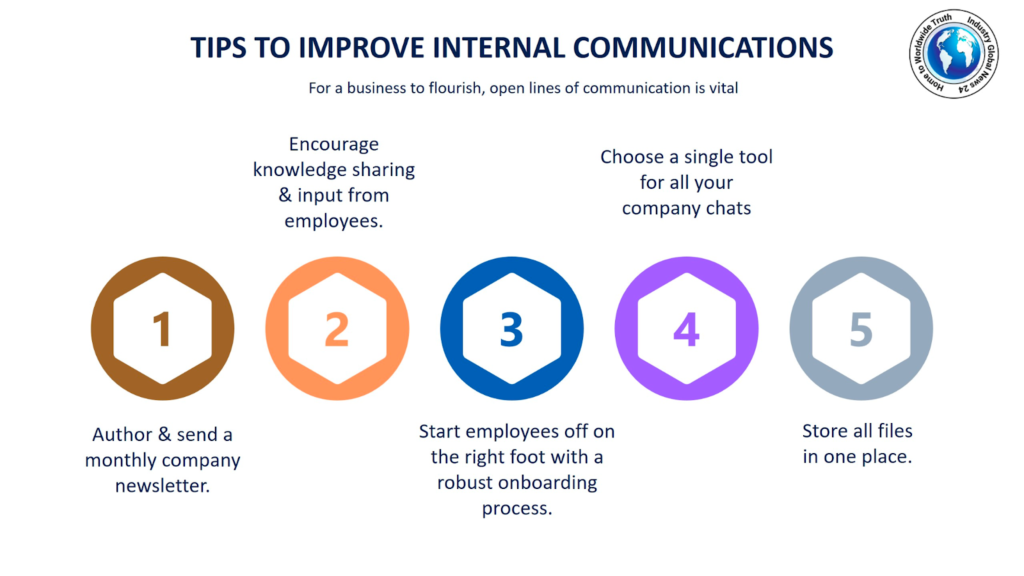Internal Communication Tips for an Effective Business
Table of Contents
- What is Internal Communication?
- Importance of Internal Communications
- Skills Required to Develop Internal Communications
- Internal Communication Tips
- Key Takeaways
- Conclusion
- FAQs
Millennials spend six hours every week on social media, whereas Generation X spends seven! Facebook alone has 1.86 billion members, with 34 of them logging in every day to view, like, comment on, and share images of their friends and current news. Sixty-two percent of American people obtain their news from social media, with 44 percent getting it from Facebook.
Wouldn’t it be great if your staff participated in your internal communications as enthusiastically as that? While some businesses fight or limit social media usage for fear of improper or unproductive use, many organizations have lately begun to embrace a more open kind of communication as they flatten their hierarchy for better agility and creativity.

What is Internal Communication?
The word “internal communications” may be defined in various ways. According to one of the most accurate definitions, the purpose of corporate internal communication strategies is to get workers on board with the firm’s policies. This is performed via the use of digital and physical ways to educate, engage, motivate, and influence employees at all levels of the organization, from the most junior roles to executives.
The Importance of Internal Communication

Communication is essential to the success and enjoyment of every kind of relationship. A strong internal communication strategy frequently speaks volumes about the organization’s overall health in the workplace. Nonetheless, strategies to increase internal communication are often overlooked as a company priority. Here are some of the advantages:
Millennials desire to communicate, listen, and work together. They want openness and criticism, as well as rationale and purpose. To do this, a company must provide excellent communication.
When the internal workplace plan is well-thought-out, workers may realize that their job matters. It encourages them to support the company’s vision and aims.
Communication is a two-way street. Internal communication encourages workers to express their ideas and concerns with people in the company who have the authority to make changes. As generational and cultural boundaries are torn down in favor of a feeling of belonging for everyone, information flows easily amongst workers.
Above all, organizations must be adaptable to flourish. To remain competitive, firms must constantly adapt and change the goalposts to keep staff engaged and going in the same direction – this necessitates a robust internal communications strategy. Internal communications are an efficient means of disseminating information within the organization. It keeps workers updated straightforwardly and efficiently, which helps to keep them motivated.
Skills Required to Develop Internal Communications
1. The audience’s attention
Always keep your audience in mind: who are they? What are their views, needs, and points of view? Create internal communications with these questions in mind, and consider what you want people to do as a consequence. Don’t bother emailing it if you don’t know the solution.
2. Capability to work together
How can you expect to reach your communication goals if you don’t work effectively with others? Don’t be arrogant and believe that your perspective is superior to others; instead, be collaborative and surround yourself with people, friends, and coworkers that share your enthusiasm.
3. The ability to say “no.”
It is critical to have the courage to go against the trend and say ‘no’ to choices. It’s pointless to nod along and consent to choices if you know deep down that it’s the wrong thing to do. Speak out, be confident, and provide a platform for employees to express their true feelings.
4. Consistency
Provide new information frequently in an easy-to-digest way. Keep it brief, to-the-point, and to the point. Long, thorough forms of communication will not resound and attractive, bite-sized morsels of information.
Internal Communication Tips

Begin with you
Everyone likes to work with open and communicative colleagues, but how would you evaluate your own communication skills? Many individuals recognize that they can improve how they share ideas and information with others, which is why analyzing your communication style is an excellent place to start.
Your duty as a leader is to foster an open internal communication culture and set a standard for how employees interact inside your organization. Remember that successful communication begins with you; therefore, assessing your communication abilities will encourage your colleagues to follow your example.
Designate a point of contact
If your workers work in a distant location, your HR department may not be particularly helpful. Even if the human resources department’s purpose is to ensure the well-being of your staff, you may not find them to be particularly helpful. As a result, you must designate a point person who is well-liked by the individuals in your firm. This will allow your staff to reach out to them when they are in need and start an open-door dialogue.
Make use of an anonymous “suggestion box.”
As old-fashioned as it may seem, this is yet another excellent technique to increase workplace communication fast and effortlessly. People aren’t always comfortable airing their grievances in public, which is why an anonymous method may be precisely what’s needed to encourage honest and open criticism.
You just need a box, a pad of paper, and a pen. You may, of course, send your staff to a virtual version that serves the same function. And, with a tool like an employee app, implementing one may be just as simple. It’ll likely take some time to properly get your team on board with the notion of providing ideas. But don’t give up hope. If recommendations are sluggish to come, have your team leader encourage her peers and maybe even break the ice by proposing modifications herself. (“I propose that we all utilize the suggestion box!”) The important conclusion is that eliciting frequent feedback and honest appraisal will lead to ongoing development if you act on it.
Examine your current internal communication plan
Improving internal communications is difficult if you don’t know what’s causing your issues. To begin, consider how many channels your firm uses. Email, team chats, video conferencing systems, and even the telephone offer advantages and disadvantages.
Some will, however, be more efficient than others. Email, for example, is not the ideal method to communicate with someone, which is why some businesses choose social intranets and collaboration tools. Make a list of your present internal communication tools and provide an honest assessment of which ones you believe are effective and which need to be upgraded or removed.
When you begin to make adjustments, seek tools that enable you to be versatile in your communication techniques and make it simple to experiment with alternative forms. You have various options, including interviews, reports, discussions, films, comics, commentary, podcasts, infographics, and webinars.
Encourage social interactions at work.
Facilitating non-work-related communication may result in increased engagement. According to Future Workspace research, having friends at work is the most important factor in having a good working life for 70% of workers.
Of course, this is more difficult to design in today’s work context. Social technologies such as instant messaging and community hubs may be pretty beneficial. They provide workers the chance to talk about matters other than work.
Establish an “open door” policy
Making time to communicate with your staff enables them to feel comfortable bringing concerns to your notice when they arise. It’s an excellent technique to boost internal communications and inspire your staff while making you more accessible.
However, don’t be afraid to invite folks in. Even if your door is wide open, no one will come through it. It’s better to set a good example by getting up from your desk and doing your own rounds.
Another option is to develop planned communication that empowers your staff, fosters trust, and fosters a free and open communication culture in your firm. Take the time to meet with your team as frequently as you believe is necessary. In addition, invite them to group conversations regarding projects, tasks, and the overall condition of your firm.
Daily standup meetings are another excellent alternative that serves a practical function. The more often you remind your staff of the status of their assignments, the better. They may be held in person or by video conference, and they can last no more than 10 minutes.
If you have the luxury of having your complete team situated in a single time zone, consider arranging your meetings at the same time every day, preferably at the start or end of working hours. However, if your team is spread out over the globe, attempt to find a time that works for everyone.
Key Takeaways
- A leader’s duty as a boss is to foster an open internal communication culture and set a standard for how employees interact inside your organization. Successful communication begins with you; therefore, assessing your communication abilities will encourage your colleagues to follow your example.
- People aren’t always comfortable airing their grievances in public, which is why an anonymous method may be precisely what’s needed to encourage honest and open criticism.
- You just need a box, a pad of paper, and a pen to start the conversation. Make a list of your present internal communication tools and provide an honest assessment of which are effective and need to be upgraded or removed.
- Making time to communicate with your staff enables them to feel comfortable bringing concerns to your notice when they arise. Invite them to group conversations regarding projects, tasks, and the overall condition of your firm.
- Daily standup meetings are another excellent alternative that serves a practical function. The more often you remind your staff of the status of their assignments, the better.
Conclusion
Having a strong internal communications plan in place may make or destroy a company. It can not only swiftly identify and remedy any present workplace concerns, but it can also keep workers engaged and enhance staff retention.
Furthermore, with the millennial age gradually taking over the workforce, fostering open dialogue and cooperation is now more crucial than ever. You must remember the three Cs: constancy, cooperation, and confidence to be successful. Examine your present internal communications plan to see whether it is effective and look for areas where it may be enhanced.
FAQs
Internal communication disseminates information about the organization so that workers may do their tasks effectively. It keeps people up to date. It also operates among workers who engage with one another in the workplace. Internal communication that is effective fosters business culture and increases employee engagement.
Internal communications software, often known as corporate messaging software, offers users instant messaging systems that enable direct and group chat inside a company. These tools are designed to be simple and accessible, allowing for fast communications among team members.
You should be aware of the five modes of communication: verbal communication, nonverbal communication, written communication, visual communication, and listening.
Internal communications (IC) is the role in charge of ensuring efficient communication among members of an organization. Internal communication refers to a set of procedures that ensure efficient information flow and cooperation among participants in a company.
Health and safety is essential aspect of internal communication in an organization. When workers begin to return to the workplace, you will send out messages outlining safety precautions and the actions your employees must follow.
Internal communication refers to communication inside a company or organization. This communication might take the shape of an official or casual conversation. Internal communication includes several departments that disseminate information to workers through various channels.
Latest Blogs
8 Free AI Tools for Blog Writing That Every Marketing VP Should Know
AI in writing offers new possibilities for authors, coders, and students. Discover how AI enhances writing books, code, essays, and emails.
Learn how AI in digital marketing, especially AI article generators, enhances content creation, personalization, and SEO to boost audience engagement and ROI.
Get your hands on the latest news!
Similar Posts

Content
9 mins read
Content Marketing vs Advertising – Which One is More Effective?

Content
11 mins read
Interactive Content vs. Static Content: Which is More Effective?

Content
6 mins read